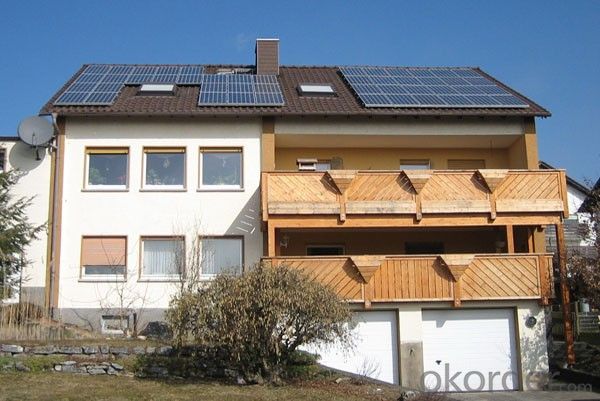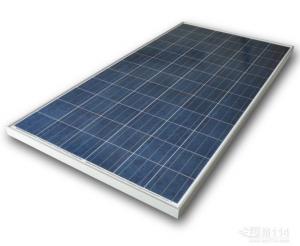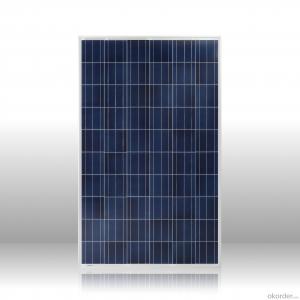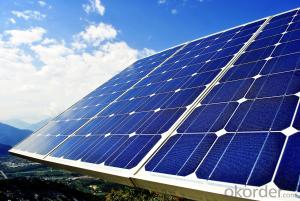Npr Solar Panels:High Power 250W/36V Poly Solar Panel with High Efficiency
- Loading Port:
- Shanghai
- Payment Terms:
- TT OR LC
- Min Order Qty:
- 100 watt
- Supply Capability:
- 10000 watt/month
OKorder Service Pledge
OKorder Financial Service
You Might Also Like
Specification

Quality Ensurance:
1. Excellent A Grade solar cell from Motech or Hanwha solar.
2. Excellent backsheet from SFC, 3M;
3. EVA from Bridgestone / First;
4. Junction box with UL and TUV listed - GZX, IP65;
5. High transmission low iron tempered glass from Xinyi Glass - China Top 1;
6. Solar panels with TUV, CE, ISO9001 certified.
Strong, lightweight aluminum frame design with reinforced sealing and load hold to prevent freezing and warping, and stand against high wind.
Under Standard Test Conditions(STC): Irradiance of 1000W/m2, Am1.5 and 25º C cell temperature
Operating Temperature: -40 ~ +85° C
Storage Temperature: -40 ~ +85° C
Mechanical Characteristics:
Dimensions: 1956mm(L) x 992mm(W) x 35mm(H)
Weight: 24kg
Polycrystalline 156*156 solar cells: 72 cells
Module Warranty:
Warranty on material and workmanship: Five years
Guaranteed output of 90% after 10 years and 80% after 25 years.
| Performance | ||
| Rated Power[Pmax] | 250W | |
| Power Tolerance | ± 3% | |
| Nominal Voltage | 36V | |
| Design Life | 25 years | |
| Electrical Characteristics | ||
| Maximum Power [Pmax] | 250W± 3% | |
| Maximum Power Voltage [Vmp] | 35.56V± 3% | |
| Maximum Power Current [Imp] | 7.031A± 3% | |
| Short-Circuit Current [Isc] | 7.80A± 3% | |
| Open-Circuit Voltage [Voc] | 43.12V± 3% | |
| Current Temperature Coefficient | 0.08%/º C | |
| Voltage Temperature Coefficient | - 0.32%/º C | |
| Power Temperature Coefficient | -0.38%/º C | |
| Maximum System Voltage | 1000V | |
- Q: What is the principle of solar panels to convert solar energy into electricity?
- optical cable communication pump Station power, seawater desalination system, urban road signs, highway signs, etc. Europe and the United States and other advanced countries will be integrated into the photovoltaic power generation system and remote areas of natural village power supply system into the development of the combination of solar cells and building systems have been formed industry Trends
- Q: Can solar panels be used to power a film set?
- Yes, solar panels can be used to power a film set. Solar panels convert sunlight into electricity, which can be used to power various equipment and lighting on a film set. This renewable energy source offers a sustainable and environmentally friendly alternative to traditional power sources.
- Q: Can solar panels be used in conjunction with a backup generator?
- Yes, solar panels can be used in conjunction with a backup generator. This setup is known as a hybrid system. During periods of sunlight, solar panels generate electricity and can power a home or facility. Any excess energy can be stored in batteries or fed back into the grid. When sunlight is insufficient, a backup generator can automatically kick in to provide electricity, ensuring a continuous power supply.
- Q: Hi,I am thinking about getting solar panels installed. # I like to cut my electric bill. #2 I like to eliminate my oil boiler and use some sort of electric boiler.I use about 5000-30000 KW per hour( winter-summer). My oil bill is around 600 month winter time. Over all i pay around 4000 a year. My electric bil now is around 2000-2500 year. Is this possible? I live in NY. I heard you can get up to $35000 rebate from LIPA( Electric company) and 2k from federal and 5k from State( is the state or federal every year?, how does that work). Any help is appreciated.
- How Solar Cells Work by way of Scott Aldous Inside This Article a million. Introduction to How Solar Cells Work two. Photovoltaic Cells: Converting Photons to Electrons three. How Silicon Makes a Solar Cell four. Anatomy of a Solar Cell five. Energy Loss in a Solar Cell 6. Solar-powering a House 7. Solving Solar-energy Issues eight. Solar-energy Pros and Cons nine. Lots More Information 0. See all Physical Science articles You've most likely visible calculators that experience sun cells -- calculators that certainly not want batteries, and in a few instances do not also have an off button. As lengthy as you have got sufficient mild, they look to paintings eternally. You could have visible better sun panels -- on emergency street indicators or name containers, on buoys, even in parking plenty to energy lighting fixtures. Although those better panels are not as ordinary as sun powered calculators, they are in the market, and no longer that rough to identify if you recognize in which to appear. There are sun mobile arrays on satellites, in which they're used to energy the electric strategies. You have most likely additionally been listening to approximately the sun revolution for the final twenty years -- the inspiration that sooner or later we can all use loose electrical power from the solar. This is a seductive promise: On a brilliant, sunny day, the solar shines roughly a million,000 watts of vigour in step with rectangular meter of the planet's floor, and if we might accumulate all of that vigour we might simply energy our houses and places of work free of charge.
- Q: I was thinking of having some installed on our rooftop and was wondering if it would be worth the cost? The house is located in Sac, Cali. The panels would face the sun 2 months out of the year and in the summer roughly 4 hours of straight sun.
- You can log in alibaba,i purchased about 20000watts 2 years ago and solar panels work efficiency is fairly high. I hope my answer help you !
- Q: How do solar panels affect the property's energy management strategy?
- Solar panels can significantly impact a property's energy management strategy by providing a renewable and sustainable source of electricity. By harnessing solar energy, the property can reduce its dependence on traditional power sources, lower energy costs, and decrease its carbon footprint. Solar panels can also help to stabilize energy prices, as they generate electricity during peak demand periods, reducing the need to purchase electricity from the grid. Additionally, solar panels can provide a reliable source of backup power during grid outages, enhancing the property's energy resilience. Overall, solar panels offer numerous advantages to a property's energy management strategy, promoting sustainability, cost savings, and energy independence.
- Q: i've heard that solar panel batteries have to be replaced withen 5-0 years. how much do solar panel batteries cost? please include sources!
- Kirraina is right the only ingredient i'm able to upload is purchase the ideal, as quickly as. in case you purchase 2nd or 0.33 ideal it is not long till you need to purchase it lower back. something I study a protracted time in the past, and it nonetheless is sensible as we talk- do you comprehend why the wealthy are wealthy? they simply yet something as quickly as! EG. a stable refrigerator will final 30 years, slightly bit junk 5-6 years. a stable refrigerator isn't 5 X greater funds than the main inexpensive one. subsequently that's the ideal deal?there is another attention, new technologies, attempt and discover something that is unquestionably upgradeable. playstation overlook approximately automobile batteries they are no longer outfitted for image voltaic platforms. you need to use ideal deep charging batteries. Sorry, definite they are costly besides.
- Q: I don't see much solar panels on people's houses where I live. I got a long time to go before doing so but I was planning on buying a few solar panels when I retire in the far future. In your opinion, is such an investment worth it? Would you buy them? I realize they are very expensive hence why I said when I retire. Thanks for your opinion
- You ask a great question, because this should really be a financial decision, and not only an environmental one. Depending on which state you live in, the payback on a system is often in the 5 to 2 year range. The great thing about solar panels is that the fuel source is free and you don't need to speculate on your future costs. You pay for the equipment up front, and then you just enjoy the free power. Most solar panel systems last at least 30 years, so compare the cost of solar panels to paying your average electric bill 360 times. And that does not include any inflation of energy cost increase. Check out our website to learn more.
- Q: Can solar panels be installed on a shaded roof?
- Yes, solar panels can be installed on a shaded roof, but their efficiency may be significantly reduced. The amount of shade and its duration throughout the day will determine the impact on energy production. It is recommended to assess the roof's shading factors and consult with a solar panel installer to determine the feasibility and potential output of a shaded installation.
Send your message to us
Npr Solar Panels:High Power 250W/36V Poly Solar Panel with High Efficiency
- Loading Port:
- Shanghai
- Payment Terms:
- TT OR LC
- Min Order Qty:
- 100 watt
- Supply Capability:
- 10000 watt/month
OKorder Service Pledge
OKorder Financial Service
Similar products
Hot products
Hot Searches
Related keywords




























